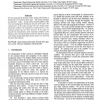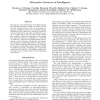399 search results - page 70 / 80 » Humanoid robot HRP-3 |
IROS
2006
IEEE
14 years 2 months ago
2006
IEEE
- This paper presents a three-layer model for generation and recognition of attention-drawing behavior. The model enables a robot to recognize people’s attention-drawing behavior...
HRI
2010
ACM
14 years 1 months ago
2010
ACM
—Based on a study of the engagement process between humans, we have developed and implemented an initial computational model for recognizing engagement between a human and a huma...
ICRA
2000
IEEE
14 years 25 days ago
2000
IEEE
We have proposed the practical torque sensqng which utilizes a flexible part of a harmonic drive gear. The sensing technique providesjoint torque sensing without reducing stiffnes...
ISER
1995
Springer
13 years 12 months ago
1995
Springer
Most robot designers make the mechanical interface between an actuator and its load as stiff as possible[9][10]. This makes sense in traditional position-controlled systems, becau...
AAAI
1998
13 years 9 months ago
1998
We present a novel methodology for building humanlike artificially intelligent systems. We take as a model the only existing systems which are universally accepted as intelligent:...


